 Search by Keyword
|
“THANK YOU GIRL”
(Paul McCartney - John Lennon)
 It’s not too often that American Beatles' fans were treated to something different in the way of a Beatles song than what was offered in their home country. There were occasions that the US received songs a couple months or more before Britain did, such as with “Long Tall Sally” and “I Call Your Name” on Capitol's "The Beatles' Second Album." But even more unique is the track “Thank You Girl.” American audiences had the privilege of hearing something quite different than what their British fans heard. This difference is focused on the harmonica parts played by John Lennon on the song. It’s not too often that American Beatles' fans were treated to something different in the way of a Beatles song than what was offered in their home country. There were occasions that the US received songs a couple months or more before Britain did, such as with “Long Tall Sally” and “I Call Your Name” on Capitol's "The Beatles' Second Album." But even more unique is the track “Thank You Girl.” American audiences had the privilege of hearing something quite different than what their British fans heard. This difference is focused on the harmonica parts played by John Lennon on the song.
 When US audiences first heard the version of the song as featured on “Past Masters, Volume One” (or possibly on a British import), it was easy to spot a noticeable difference. To American ears, it sounded drab and missing a couple vital ingredients. Because of this, purists will usually prefer to hear the song on their original vinyl copy of “The Beatles’ Second Album,” which was later made available on “The Capitol Albums, Vol. 1” box set, or the remastered stereo version featured on "Past Masters." We will examine in detail how these differences came about below under the subheading “Recording History.” When US audiences first heard the version of the song as featured on “Past Masters, Volume One” (or possibly on a British import), it was easy to spot a noticeable difference. To American ears, it sounded drab and missing a couple vital ingredients. Because of this, purists will usually prefer to hear the song on their original vinyl copy of “The Beatles’ Second Album,” which was later made available on “The Capitol Albums, Vol. 1” box set, or the remastered stereo version featured on "Past Masters." We will examine in detail how these differences came about below under the subheading “Recording History.”
Songwriting History
 The writing of “Thank You Girl” can easily be narrowed down to February of 1963 during their British nationwide tour with Helen Shapiro. Since February 11th, 1963 was the date for recording of their first British album “Please Please Me,” and the song did not appear on that album, it obviously didn’t exist yet since they would have premiered the song on that day if it had. And since Lennon later confirmed in 1980, as detailed in David Sheff's book "All We Are Saying," that the song “was one of our efforts at writing a single that didn’t work,” it had to have been written before February 28th, 1963, since this was the confirmed date when their next single “From Me To You” was written. Since “Thank You Girl” ended up as the b-side to that British single, it had to have been written sometime between February 11th and 28th of 1963, using the working title "Thank You Little Girl." The writing of “Thank You Girl” can easily be narrowed down to February of 1963 during their British nationwide tour with Helen Shapiro. Since February 11th, 1963 was the date for recording of their first British album “Please Please Me,” and the song did not appear on that album, it obviously didn’t exist yet since they would have premiered the song on that day if it had. And since Lennon later confirmed in 1980, as detailed in David Sheff's book "All We Are Saying," that the song “was one of our efforts at writing a single that didn’t work,” it had to have been written before February 28th, 1963, since this was the confirmed date when their next single “From Me To You” was written. Since “Thank You Girl” ended up as the b-side to that British single, it had to have been written sometime between February 11th and 28th of 1963, using the working title "Thank You Little Girl."
 Although the song was described by Lennon in his 1971 interview for Hit Parader magazine as “just a silly song that we knocked off,” they obviously were proud of it at the time, convinced that this would be the follow up to their recent British #1 hit “Please Please Me.” This is confirmed in the book "Beatles Anthology" by Lennon who is quoted in 1963 as saying: "We'd already written 'Thank You Girl' as the follow-up to 'Please Please Me.' This new number ('From Me To You') was to be the b-side. We were so pleased with it, we knew we just had to make it the a-side, 'Thank You Girl' the b." By the time they entered the studio on March 5th, 1963 to record both of these songs, they presumably were swayed into thinking that their more recently written song, “From Me To You” would be a better choice for their next single, since it was recorded first on that day. “Thank You Girl” was therefore relegated to the b-side. Although the song was described by Lennon in his 1971 interview for Hit Parader magazine as “just a silly song that we knocked off,” they obviously were proud of it at the time, convinced that this would be the follow up to their recent British #1 hit “Please Please Me.” This is confirmed in the book "Beatles Anthology" by Lennon who is quoted in 1963 as saying: "We'd already written 'Thank You Girl' as the follow-up to 'Please Please Me.' This new number ('From Me To You') was to be the b-side. We were so pleased with it, we knew we just had to make it the a-side, 'Thank You Girl' the b." By the time they entered the studio on March 5th, 1963 to record both of these songs, they presumably were swayed into thinking that their more recently written song, “From Me To You” would be a better choice for their next single, since it was recorded first on that day. “Thank You Girl” was therefore relegated to the b-side.
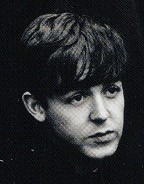 The song was written “head to head” by John and Paul, making it a fairly equal collaboration, although McCartney’s recollections clarify matters even further. “This was pretty much co-written but there might have been a slight leaning towards me with the ‘thank you, girl’ thing,” McCartney recalls, continuing "it sounds like me, trying to appease the mob." According to Ian MacDonald in his book "Revolution In The Head," "The pattern of (melodic) alternation between the two writers is clear, Lennon in the three-chord verse and McCartney in the chorus and its related middle eight. The same seems to have gone for the lyrics, Lennon initiating things with the down-to-earth first line ('you've been good to me...') and McCartney replying with the Tin Pan Alley tone and slick internal rhyme of the second ('and eternally...') Like any pop act, they were looking for variations on their previous hit, the descending scalar crotchets of 'Thank You Girl's middle eight ('thank you girl for loving me') being recycled from the verse of 'Please Please Me' ('last night I said...')." The song was written “head to head” by John and Paul, making it a fairly equal collaboration, although McCartney’s recollections clarify matters even further. “This was pretty much co-written but there might have been a slight leaning towards me with the ‘thank you, girl’ thing,” McCartney recalls, continuing "it sounds like me, trying to appease the mob." According to Ian MacDonald in his book "Revolution In The Head," "The pattern of (melodic) alternation between the two writers is clear, Lennon in the three-chord verse and McCartney in the chorus and its related middle eight. The same seems to have gone for the lyrics, Lennon initiating things with the down-to-earth first line ('you've been good to me...') and McCartney replying with the Tin Pan Alley tone and slick internal rhyme of the second ('and eternally...') Like any pop act, they were looking for variations on their previous hit, the descending scalar crotchets of 'Thank You Girl's middle eight ('thank you girl for loving me') being recycled from the verse of 'Please Please Me' ('last night I said...')."
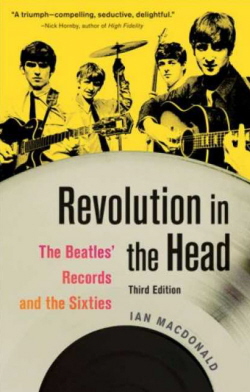 As to their general intention for the lyrics, both Lennon and McCartney had in mind to acknowledge their female fans in gratitude for their part in The Beatles success up to that point. According to Ian MacDonalds's book "Revolution In The Head," "When fans mobbed his Rolls-Royce one night...(Lennon) told his chauffeur not to worry: 'They bought the car. They've got a right to smash it up.'" “We knew that if we wrote a song called ‘Thank You Girl’ that a lot of the girls who wrote us fan letters would take it as a genuine thank you,” stated McCartney in 1988. “So a lot of our songs were directly addressed to the fans.” As to their general intention for the lyrics, both Lennon and McCartney had in mind to acknowledge their female fans in gratitude for their part in The Beatles success up to that point. According to Ian MacDonalds's book "Revolution In The Head," "When fans mobbed his Rolls-Royce one night...(Lennon) told his chauffeur not to worry: 'They bought the car. They've got a right to smash it up.'" “We knew that if we wrote a song called ‘Thank You Girl’ that a lot of the girls who wrote us fan letters would take it as a genuine thank you,” stated McCartney in 1988. “So a lot of our songs were directly addressed to the fans.”
 Another common practice for John and Paul was to include personal pronouns in the titles of their songs in order to accentuate the connection between the group and their fans. Since this practice was put in force primarily for singles only (which lasted until “A Hard Day’s Night”), this fact appears to further confirm their original intention of “Thank You Girl” being their next single. Another common practice for John and Paul was to include personal pronouns in the titles of their songs in order to accentuate the connection between the group and their fans. Since this practice was put in force primarily for singles only (which lasted until “A Hard Day’s Night”), this fact appears to further confirm their original intention of “Thank You Girl” being their next single.
 In retrospect, both Lennon and McCartney unfortunately viewed the song with little regard. “A bit of a hack song really,” McCartney stated, “but all good practice.” After stating that the song didn’t work, Lennon continued, “so it became a b-side or an album track.” It was admitted by Paul, though, in his 1997 book "Many Years From Now" that "Thank You Girl" helped develop their songwriting career. “These early songs were wonderful to learn by and were good album fillers.” In retrospect, both Lennon and McCartney unfortunately viewed the song with little regard. “A bit of a hack song really,” McCartney stated, “but all good practice.” After stating that the song didn’t work, Lennon continued, “so it became a b-side or an album track.” It was admitted by Paul, though, in his 1997 book "Many Years From Now" that "Thank You Girl" helped develop their songwriting career. “These early songs were wonderful to learn by and were good album fillers.”
Recording History
 With the George Martin / Brian Epstein plan to release a new Beatles single every three months, the group was ushered into the recording studio on March 5th, 1963, which was their only free day in weeks, to quickly record their next single. “Please Please Me” was still doing great on the British charts and their first album wasn’t even released yet, but the ‘powers that be’ were making sure that The Beatles’ name would continue to be on the minds of British fans. With the George Martin / Brian Epstein plan to release a new Beatles single every three months, the group was ushered into the recording studio on March 5th, 1963, which was their only free day in weeks, to quickly record their next single. “Please Please Me” was still doing great on the British charts and their first album wasn’t even released yet, but the ‘powers that be’ were making sure that The Beatles’ name would continue to be on the minds of British fans.
 Two recording sessions in EMI Studio Two were scheduled on this day, the first (from 2:30 to 5:30 pm) being utilized for recording both sides of their next single. After “From Me To You” was started and fully completed, “Thank You Girl” began at approximately 4 pm. Six full band takes of the song were recorded with the group playing their usual instruments, guitars, bass and drums, as well as performing all of the vocals. Two recording sessions in EMI Studio Two were scheduled on this day, the first (from 2:30 to 5:30 pm) being utilized for recording both sides of their next single. After “From Me To You” was started and fully completed, “Thank You Girl” began at approximately 4 pm. Six full band takes of the song were recorded with the group playing their usual instruments, guitars, bass and drums, as well as performing all of the vocals.
 The official EMI tape box for this day has the song listed by its working title “Thank You Little Girl,” despite the word “little” only appearing once during the second verse. Since this documentation usually consisted of an engineers’ handwritten scribbles that day on the tape box, doubt can easily be had as to this title still being actually considered by the group since the phrase “thank you girl” is repeated nine times in the lyrics without ever including the word “little.” It could easily be concluded that either John or Paul mistakenly referred to the song by this title and the engineer jotted it down that way at the beginning of the session. The official EMI tape box for this day has the song listed by its working title “Thank You Little Girl,” despite the word “little” only appearing once during the second verse. Since this documentation usually consisted of an engineers’ handwritten scribbles that day on the tape box, doubt can easily be had as to this title still being actually considered by the group since the phrase “thank you girl” is repeated nine times in the lyrics without ever including the word “little.” It could easily be concluded that either John or Paul mistakenly referred to the song by this title and the engineer jotted it down that way at the beginning of the session.
 According to Mark Lewisohn's book "The Beatles Recording Sessions," "Thank You Girl" was "recorded in six takes, with seven additional edit piece takes of the guitar flourish at the end. It was decided that the best was to be an edit of takes six and 13." However, released session tape evidence shows that these "additional edit piece takes" concerned, at least in part, Ringo's performance on drums. According to Mark Lewisohn's book "The Beatles Recording Sessions," "Thank You Girl" was "recorded in six takes, with seven additional edit piece takes of the guitar flourish at the end. It was decided that the best was to be an edit of takes six and 13." However, released session tape evidence shows that these "additional edit piece takes" concerned, at least in part, Ringo's performance on drums.
 The closing of the song needed to be spruced up, so the group, probably at the suggestion of George Martin, performed seven attempts of an edit piece to close the song. The edit piece consisted of the Buddy Holly-like “oh, oh” opening segment of the verses with a Sandy Nelson- Tony Meehan-like drum solo by Ringo. After this was repeated twice, the “oh, oh” segment appears a third time followed by an energetic accentuated ending. The closing of the song needed to be spruced up, so the group, probably at the suggestion of George Martin, performed seven attempts of an edit piece to close the song. The edit piece consisted of the Buddy Holly-like “oh, oh” opening segment of the verses with a Sandy Nelson- Tony Meehan-like drum solo by Ringo. After this was repeated twice, the “oh, oh” segment appears a third time followed by an energetic accentuated ending.
 Since Ringo has gone on record as stating that he despises drum solos, he relented and impressively performed the two solo sections. This is not to say that it came easily for him; hence the seven attempts to nail this edit piece. Lennon can be heard on the original session tapes between these takes saying that Ringo wasn’t “on the beat.” Nonetheless they eventually got it right, the seventh attempt, or "take 13," being the best. A decision was also made to increase the reverb on this ending section of the song, so a noticeable fullness permeates the last measures. At 5:30 pm, this session was complete, editing of the appropriate takes being accomplished either at the conclusion of this earlier session or sometime during the later EMI Studio Two session on this day, which spanned from 7 to 10 pm. Since Ringo has gone on record as stating that he despises drum solos, he relented and impressively performed the two solo sections. This is not to say that it came easily for him; hence the seven attempts to nail this edit piece. Lennon can be heard on the original session tapes between these takes saying that Ringo wasn’t “on the beat.” Nonetheless they eventually got it right, the seventh attempt, or "take 13," being the best. A decision was also made to increase the reverb on this ending section of the song, so a noticeable fullness permeates the last measures. At 5:30 pm, this session was complete, editing of the appropriate takes being accomplished either at the conclusion of this earlier session or sometime during the later EMI Studio Two session on this day, which spanned from 7 to 10 pm.
 According to Geoff Emerick's recollections detailed in his book "Here, There And Everywhere," this editing may have been more extensive than detailed above. Geoff Emerick was commissioned as second engineer at the very next Beatles recording session, this occurring on March 13th, 1963 in EMI Studio Two between 10 am and 1 pm. The purpose of this session was for a "harmonica overdub on the song 'Thank You Girl,'" Geoff Emerick recalls, adding: "Actually, it wasn't so much a Beatles session as it was a John Lennon session. He came in on his own to do it, despite the fact that he had a terrible cold. It came out in the course of conversation that he'd been home the night before and missed the band's gig: that's how sick he was. He staggered into the studio white as a sheet - he must have come straight from bed, and he had a hoarse voice. Lennon was croaking and sneezing, blowing his nose every few seconds. He was in terrible shape, but the pressures of the recording industry forced him from a sickbed and into a drafty studio. That's how little available time the constantly touring Beatles had at that point in their career." According to Geoff Emerick's recollections detailed in his book "Here, There And Everywhere," this editing may have been more extensive than detailed above. Geoff Emerick was commissioned as second engineer at the very next Beatles recording session, this occurring on March 13th, 1963 in EMI Studio Two between 10 am and 1 pm. The purpose of this session was for a "harmonica overdub on the song 'Thank You Girl,'" Geoff Emerick recalls, adding: "Actually, it wasn't so much a Beatles session as it was a John Lennon session. He came in on his own to do it, despite the fact that he had a terrible cold. It came out in the course of conversation that he'd been home the night before and missed the band's gig: that's how sick he was. He staggered into the studio white as a sheet - he must have come straight from bed, and he had a hoarse voice. Lennon was croaking and sneezing, blowing his nose every few seconds. He was in terrible shape, but the pressures of the recording industry forced him from a sickbed and into a drafty studio. That's how little available time the constantly touring Beatles had at that point in their career."
 John’s cold was so bad that he actually missed The Beatles performance the night before at the Granada Cinema in Bedford, England, during the group's second national tour with Chris Montez and Tommy Roe, not to mention their evening gig at the Rialto Theatre in York that day. The three-man Beatles had to rearrange the vocals of songs such as “Please Please Me” to cover up for John’s absence. John’s cold was so bad that he actually missed The Beatles performance the night before at the Granada Cinema in Bedford, England, during the group's second national tour with Chris Montez and Tommy Roe, not to mention their evening gig at the Rialto Theatre in York that day. The three-man Beatles had to rearrange the vocals of songs such as “Please Please Me” to cover up for John’s absence.
 Geoff Emerick continues: "George Martin clearly felt sorry for the unusually subdued John and pandered to him, doing everything he could to make sure Lennon was comfortable. John, as it turned out, was so foggy from his illness that he had forgotten to bring his harmonica along. There was some talk of dispatching (Beatles roadie) Mal Evans to the nearest music shop to buy one, but then I remembered that my mate Malcolm Davies played a bit of harmonica to amuse himself. John shuffled up to the masteering room himself and borrowed it. As the tape played, I noticed a ton of edits flying by. Checking the notes on the tape box, I saw that the master (tape) was made up of six different takes, which Norman (Smith) had edited together a few days beforehand (undoubtedly March 5th, 1963) so that everything was ready for John's overdub. Obviously the band hadn't been able to play it all the way through, even though it sounded like a very simple song. It took John more than a dozen takes to add those little harmonica bits, too, not because he couldn't play them, but because he kept sneezing and snuffling." Geoff Emerick continues: "George Martin clearly felt sorry for the unusually subdued John and pandered to him, doing everything he could to make sure Lennon was comfortable. John, as it turned out, was so foggy from his illness that he had forgotten to bring his harmonica along. There was some talk of dispatching (Beatles roadie) Mal Evans to the nearest music shop to buy one, but then I remembered that my mate Malcolm Davies played a bit of harmonica to amuse himself. John shuffled up to the masteering room himself and borrowed it. As the tape played, I noticed a ton of edits flying by. Checking the notes on the tape box, I saw that the master (tape) was made up of six different takes, which Norman (Smith) had edited together a few days beforehand (undoubtedly March 5th, 1963) so that everything was ready for John's overdub. Obviously the band hadn't been able to play it all the way through, even though it sounded like a very simple song. It took John more than a dozen takes to add those little harmonica bits, too, not because he couldn't play them, but because he kept sneezing and snuffling."
 There were six segments of harmonica needed to fill out the song, but it took 15 takes to get them all recorded, this being set to tape approximately between 10 and 11 am. After his work was completed, John went back up to the mastering room to return the harmonica to Malcolm Davies, not thanking him, but instead complaining that it “tasted like a sack of potatoes.” "I only hope that Malcolm thought to disinfect it before playing it next," Geoff Emerick comments, "or he would have caught one hell of a cold." There were six segments of harmonica needed to fill out the song, but it took 15 takes to get them all recorded, this being set to tape approximately between 10 and 11 am. After his work was completed, John went back up to the mastering room to return the harmonica to Malcolm Davies, not thanking him, but instead complaining that it “tasted like a sack of potatoes.” "I only hope that Malcolm thought to disinfect it before playing it next," Geoff Emerick comments, "or he would have caught one hell of a cold."
 Geoff Emerick also described the recording procedure for these harminca overdubs. "Once Lennon trundled off to return to home, hearth, and cough syrup, each harmonica lick was separately edited into the master tape so that the whole recording didn't go down a generation. In theory, the balance engineers weren't allowed to do their own editing. EMI had its own editing department, and the prescribed procedure was to have the producer indicate the edits he wanted on a sheet of manuscript paper, which would be carried out by the editing staff the next day, but Norman (Smith) generally ignored that edict. For one thing, he enjoyed doing edits; for another, doing them himself was the fastest, most expedient way, and, of course, everyone wanted to hear the results right away. Rules were already beginning to be broken for Beatles sessions, a reflection of how much money they were starting to generate for the label." Geoff Emerick also described the recording procedure for these harminca overdubs. "Once Lennon trundled off to return to home, hearth, and cough syrup, each harmonica lick was separately edited into the master tape so that the whole recording didn't go down a generation. In theory, the balance engineers weren't allowed to do their own editing. EMI had its own editing department, and the prescribed procedure was to have the producer indicate the edits he wanted on a sheet of manuscript paper, which would be carried out by the editing staff the next day, but Norman (Smith) generally ignored that edict. For one thing, he enjoyed doing edits; for another, doing them himself was the fastest, most expedient way, and, of course, everyone wanted to hear the results right away. Rules were already beginning to be broken for Beatles sessions, a reflection of how much money they were starting to generate for the label."
 According to Mark Lewisohn's book "The Beatles Recording Sessions," there ended up being six takes that Norman Smith meticulously edited together that afternoon. These consisted of "take six" of the bulk of the song, "take 13" of the conclusion with Ringo's drum solos, "take 17" of John's harmonica in the introduction, "take 20" of the harmonica just before the second verse begins, "take 21" of the two harmonica segments heard in the bridge (just after the lyrics "the way that you do" and "too good to be true") and "take 23" of the harmonica at the song's conclusion. According to Mark Lewisohn's book "The Beatles Recording Sessions," there ended up being six takes that Norman Smith meticulously edited together that afternoon. These consisted of "take six" of the bulk of the song, "take 13" of the conclusion with Ringo's drum solos, "take 17" of John's harmonica in the introduction, "take 20" of the harmonica just before the second verse begins, "take 21" of the two harmonica segments heard in the bridge (just after the lyrics "the way that you do" and "too good to be true") and "take 23" of the harmonica at the song's conclusion.
 Afterwards, George Martin and engineers Norman Smith and Geoff Emerick stuck around until 1 pm to create both the mono and stereo mixes of the song. Since usually only mono mixes were required for songs being issued as singles, they may not have been sure at this stage if the song would be released on an album, which did require a stereo mix. Britain didn’t get an album release for the song in the '60s so the stereo mix was not released in the UK at that time. America did get treated to this interesting stereo mix on “The Beatles’ Second Album.” Afterwards, George Martin and engineers Norman Smith and Geoff Emerick stuck around until 1 pm to create both the mono and stereo mixes of the song. Since usually only mono mixes were required for songs being issued as singles, they may not have been sure at this stage if the song would be released on an album, which did require a stereo mix. Britain didn’t get an album release for the song in the '60s so the stereo mix was not released in the UK at that time. America did get treated to this interesting stereo mix on “The Beatles’ Second Album.”
 When the stereo mix was performed on this day, it included three harmonica segments that weren’t deemed worthy of being included on the mono mix. Great care usually went into the mono mixes since this was what most record buyers played on their record players and radio stations played. For some reason, they took the extra work of including these other three harmonica segments, two of which occur in the bridge and one at the conclusion of the song. Another difference is in the fifth harmonica segment, which on the stereo mix begins before the one-beat of the measure, strategically covering up the edit previously made between the first and second sections of the song. This edit may have been more noticeable in stereo so they picked a different take of that harmonica segment to cover it up. When the stereo mix was performed on this day, it included three harmonica segments that weren’t deemed worthy of being included on the mono mix. Great care usually went into the mono mixes since this was what most record buyers played on their record players and radio stations played. For some reason, they took the extra work of including these other three harmonica segments, two of which occur in the bridge and one at the conclusion of the song. Another difference is in the fifth harmonica segment, which on the stereo mix begins before the one-beat of the measure, strategically covering up the edit previously made between the first and second sections of the song. This edit may have been more noticeable in stereo so they picked a different take of that harmonica segment to cover it up.
 This is the version millions of American record buyers were familiar with on “The Beatles’ Second Album.” Since Capitol constructed “mono Type B” versions of Beatles songs taken from the stereo masters received from George Martin, a method which combined both the left and right channels of the stereo mix to create a new mono mix, both the mono and stereo versions of this American album contained these harmonica segments. Capitol was also in the habit of adding reverb to Beatles songs to give them more fullness, and this is what they did to “Thank You Girl.” Since a fair amount of reverb was already present in the closing measures of the song, the ending became extremely full sounding with a double dose of reverb. Although the song previously appeared as the b-side of both “From Me To You” and “Do You Want To Know A Secret” on the American Vee-Jay label using the original mono mix, most American Beatles fans were unacquainted with the original mono version without those harmonica segments and added reverb until the “Past Masters, Volume One” CD came out in 1988. This is the version millions of American record buyers were familiar with on “The Beatles’ Second Album.” Since Capitol constructed “mono Type B” versions of Beatles songs taken from the stereo masters received from George Martin, a method which combined both the left and right channels of the stereo mix to create a new mono mix, both the mono and stereo versions of this American album contained these harmonica segments. Capitol was also in the habit of adding reverb to Beatles songs to give them more fullness, and this is what they did to “Thank You Girl.” Since a fair amount of reverb was already present in the closing measures of the song, the ending became extremely full sounding with a double dose of reverb. Although the song previously appeared as the b-side of both “From Me To You” and “Do You Want To Know A Secret” on the American Vee-Jay label using the original mono mix, most American Beatles fans were unacquainted with the original mono version without those harmonica segments and added reverb until the “Past Masters, Volume One” CD came out in 1988.
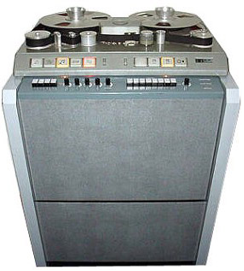 One noticeable difference between the actual session tapes and all of the released versions of the song is the tempo. Geoff Emerick states in his book "Here, There And Everywhere": "Listening to 'Thank You Girl' today, it obviously got inadvertenly sped up at some point, though we didn't have varispeed on the two-track machines in those days, so it must have happened during mastering, or when tape copies were made. Varispeed came later, with a sweep oscillator and a huge power supply that provided varying voltage to the motors. It was a technological innovation that would open the door to lots of new, exciting sounds on future Beatles recordings." One noticeable difference between the actual session tapes and all of the released versions of the song is the tempo. Geoff Emerick states in his book "Here, There And Everywhere": "Listening to 'Thank You Girl' today, it obviously got inadvertenly sped up at some point, though we didn't have varispeed on the two-track machines in those days, so it must have happened during mastering, or when tape copies were made. Varispeed came later, with a sweep oscillator and a huge power supply that provided varying voltage to the motors. It was a technological innovation that would open the door to lots of new, exciting sounds on future Beatles recordings."
 The Beatles recorded "Thank You Girl" three more times in 1963, these being recorded specifically for BBC radio. The first was recorded on April 1st in Studio One of BBC Piccadilly Studios in London between 6:30 and 10:30 pm for the BBC program“Side By Side,” which was broadcast on May 13th between 5 and 5:29 pm. A personal recording of the song was done on April 4th, 1963 at Roxburgh Hall, Stowe School in Stowe, Bucks, during an hour-long concert The Beatles played from 6:30 to 7:30 pm, these 22 songs being caught on a reel-to-reel tape by student John Bloomfield a week before the song was released in the UK. The Beatles recorded "Thank You Girl" three more times in 1963, these being recorded specifically for BBC radio. The first was recorded on April 1st in Studio One of BBC Piccadilly Studios in London between 6:30 and 10:30 pm for the BBC program“Side By Side,” which was broadcast on May 13th between 5 and 5:29 pm. A personal recording of the song was done on April 4th, 1963 at Roxburgh Hall, Stowe School in Stowe, Bucks, during an hour-long concert The Beatles played from 6:30 to 7:30 pm, these 22 songs being caught on a reel-to-reel tape by student John Bloomfield a week before the song was released in the UK.
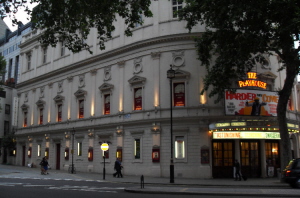 The second BBC recording was done on May 21st at the Playhouse Theatre in London before a live audience between 10 and 11:15 pm for the show “Steppin’ Out,” which was produced by Terry Henebery and broadcast on June 3rd between 10:31 and 11:30 pm. The final recording of "Thank You Girl" was the one that made it onto the “Live At The BBC” album, this being recorded before a live audience at the Playhouse Theatre in London on June 19th between 8:45 and 9:45 pm, this being produced by Ron Belchier. This recording was broadcast on the show “Easy Beat” on July 23rd between 10:31 and 11:30 pm. The second BBC recording was done on May 21st at the Playhouse Theatre in London before a live audience between 10 and 11:15 pm for the show “Steppin’ Out,” which was produced by Terry Henebery and broadcast on June 3rd between 10:31 and 11:30 pm. The final recording of "Thank You Girl" was the one that made it onto the “Live At The BBC” album, this being recorded before a live audience at the Playhouse Theatre in London on June 19th between 8:45 and 9:45 pm, this being produced by Ron Belchier. This recording was broadcast on the show “Easy Beat” on July 23rd between 10:31 and 11:30 pm.
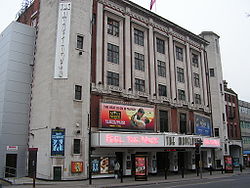 On August 21st, 1963, during a six night residency in Bournemouth, Hants, England, a technician at the Gaumont Cinema recorded The Beatles performance on his reel-to-reel tape recorder in order to check the venue's sound system. The second song in their set list on this night was "Thank You Girl." This rather clear sounding 25-minute tape reel was sold by Christie's auction house in 1998 for 25,300 pounds and has not yet been made available commercially. On August 21st, 1963, during a six night residency in Bournemouth, Hants, England, a technician at the Gaumont Cinema recorded The Beatles performance on his reel-to-reel tape recorder in order to check the venue's sound system. The second song in their set list on this night was "Thank You Girl." This rather clear sounding 25-minute tape reel was sold by Christie's auction house in 1998 for 25,300 pounds and has not yet been made available commercially.
Song Structure and Style
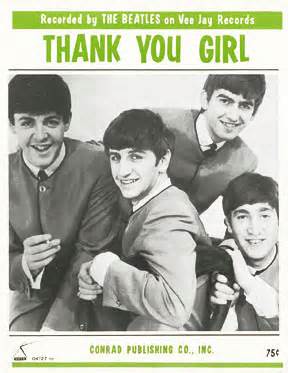 At first glance, “Thank You Girl” appears to have the same 'verse/ verse/ bridge/ verse' structure that most of the early Beatles catalog used. On closer examination, though, we see more intricate detail which makes this song unique. This detail includes the identification of two elements which are both repeated within the song's structure and therefore need to be viewed as separate entities. At first glance, “Thank You Girl” appears to have the same 'verse/ verse/ bridge/ verse' structure that most of the early Beatles catalog used. On closer examination, though, we see more intricate detail which makes this song unique. This detail includes the identification of two elements which are both repeated within the song's structure and therefore need to be viewed as separate entities.
The first element we’ll analyze is the introductory four measures. Since this introduction is actually heard three times in the song, it cannot be dismissed as a one time thing to be disregarded within the song’s structure. Also, since the introduction is sometimes heard introducing the verse, this is not always the case, so it cannot be identified as part of the verse. Therefore this four-measure introduction needs to be viewed as a distinct element of the song. We’ll refer to this element as the introduction.
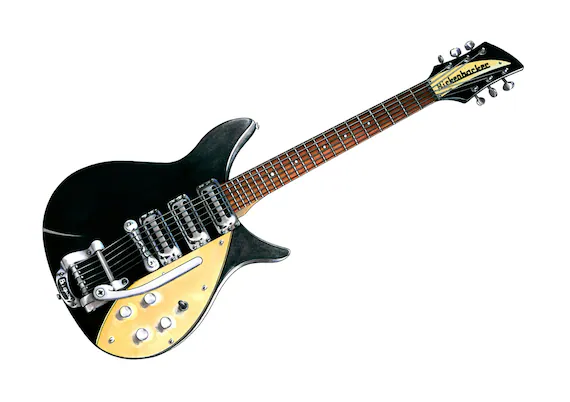 The second element under analysis is the four measures that encompass the key phrase “and all I gotta do is thank you girl, thank you girl.” While it may be suggested that this is part of the verse, the bridge also ends with this same four measures, suggesting that this also should be viewed as a distinct element of the song. Since identifying this element as a "chorus" is uncharacteristic due to its position within the structure of the song as well as the brevity of four measures, we’ll refer to this element as the "refrain." The second element under analysis is the four measures that encompass the key phrase “and all I gotta do is thank you girl, thank you girl.” While it may be suggested that this is part of the verse, the bridge also ends with this same four measures, suggesting that this also should be viewed as a distinct element of the song. Since identifying this element as a "chorus" is uncharacteristic due to its position within the structure of the song as well as the brevity of four measures, we’ll refer to this element as the "refrain."
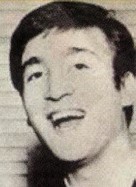 All this having been said, the structure of the song turns out to appear as follows: “introduction/ verse/ refrain/ verse/ refrain/ bridge/ refrain/ introduction/ verse/ refrain/ introduction.” (A shortened or abbreviated form would be abcbcdcabca, which of course doesn’t look very abbreviated.) No other Beatles song, nor any other song in the annals of recorded music (I would think), has this structure, which makes “Thank You Girl” very unique indeed. All this having been said, the structure of the song turns out to appear as follows: “introduction/ verse/ refrain/ verse/ refrain/ bridge/ refrain/ introduction/ verse/ refrain/ introduction.” (A shortened or abbreviated form would be abcbcdcabca, which of course doesn’t look very abbreviated.) No other Beatles song, nor any other song in the annals of recorded music (I would think), has this structure, which makes “Thank You Girl” very unique indeed.
 To complicate matters even more, the four-measure introduction is actually broken down into two distinct sections, two measures each. The first two measures feature Lennon’s harmonica flourish and Ringo’s tom-tom heavy drumbeat. The second two measures feature the appearance of the Buddy Holly-like “oh, oh, mmm” harmony vocals. This leads directly into the first eight-measure verse, which features unison singing from John and Paul in the first four measures and higher register harmony singing from Paul in the last four measures. We then hear the distinct four-measure refrain for the first time which hits home the title of the song. Unison vocals return for the refrain except for the strategic word “do” which shows Paul jump to a high register harmony note, which has already become somewhat of a trademark for Beatles songs as of mid 1963. To complicate matters even more, the four-measure introduction is actually broken down into two distinct sections, two measures each. The first two measures feature Lennon’s harmonica flourish and Ringo’s tom-tom heavy drumbeat. The second two measures feature the appearance of the Buddy Holly-like “oh, oh, mmm” harmony vocals. This leads directly into the first eight-measure verse, which features unison singing from John and Paul in the first four measures and higher register harmony singing from Paul in the last four measures. We then hear the distinct four-measure refrain for the first time which hits home the title of the song. Unison vocals return for the refrain except for the strategic word “do” which shows Paul jump to a high register harmony note, which has already become somewhat of a trademark for Beatles songs as of mid 1963.
 The verse/refrain pattern then continues, which is performed identically except for a different set of lyrics in this second verse. We now see the bridge appear for its only time in the song, which is eight measures long. The descending quarter note melody line of the bridge appears to be a repeat of the same idea used in the verses of their previous British hit “Please Please Me.” The vocals are sung in unison throughout except for the repeat of the words “way that you do” in the fourth measure. A natural inclination would be to also repeat the phrase “good to be true” in the eighth measure, but this was left blank in order to add that melodic phrase with harmonica at the later recording session. George Martin apparently decided this wasn’t needed for the predominant mono mix, so it was left off during that mixing session. The verse/refrain pattern then continues, which is performed identically except for a different set of lyrics in this second verse. We now see the bridge appear for its only time in the song, which is eight measures long. The descending quarter note melody line of the bridge appears to be a repeat of the same idea used in the verses of their previous British hit “Please Please Me.” The vocals are sung in unison throughout except for the repeat of the words “way that you do” in the fourth measure. A natural inclination would be to also repeat the phrase “good to be true” in the eighth measure, but this was left blank in order to add that melodic phrase with harmonica at the later recording session. George Martin apparently decided this wasn’t needed for the predominant mono mix, so it was left off during that mixing session.
 After we hear another identical refrain and a repeat of the introduction, we enter into the third verse, which is actually a repeat of the first verse performed identically. After the final refrain is heard, we go back to the introduction which actually appears as an extended version which encompasses a whopping fourteen measures. After the first two harmonica measures, the Buddy Holly-like harmony vocals reappear, but this time repeating “oh” three times instead of two. Ringo then treats us to a two-measure “drum solo” accompanied by the rest of the group vamping along. This pattern is repeated, giving us a somewhat different 'drum solo' from Ringo. The pattern appears to be repeating for a third time, but after two “oh”s, the group goes in for the dramatic finish ending on the fourteenth measure. Lennon’s harmonica flourish adds a nice touch, but not nice enough for George Martin to include in the finished mono mix. After we hear another identical refrain and a repeat of the introduction, we enter into the third verse, which is actually a repeat of the first verse performed identically. After the final refrain is heard, we go back to the introduction which actually appears as an extended version which encompasses a whopping fourteen measures. After the first two harmonica measures, the Buddy Holly-like harmony vocals reappear, but this time repeating “oh” three times instead of two. Ringo then treats us to a two-measure “drum solo” accompanied by the rest of the group vamping along. This pattern is repeated, giving us a somewhat different 'drum solo' from Ringo. The pattern appears to be repeating for a third time, but after two “oh”s, the group goes in for the dramatic finish ending on the fourteenth measure. Lennon’s harmonica flourish adds a nice touch, but not nice enough for George Martin to include in the finished mono mix.
 Lyrically the song can be viewed as pedestrian and with its share of clichés, such as “eternally I’ll always be in love with you” and a “love that is too good to be true.” Since the words were quickly written with the intention of thanking their female fans for their support up to that point, the lyrics suit their purpose perfectly. Also, the words were slanted to sound like it was a love song between two people so it could be universally accepted. The irresistibility of the song rests on the arrangement and unique songwriting talents being displayed, not to mention the harmonies. Lyrically the song can be viewed as pedestrian and with its share of clichés, such as “eternally I’ll always be in love with you” and a “love that is too good to be true.” Since the words were quickly written with the intention of thanking their female fans for their support up to that point, the lyrics suit their purpose perfectly. Also, the words were slanted to sound like it was a love song between two people so it could be universally accepted. The irresistibility of the song rests on the arrangement and unique songwriting talents being displayed, not to mention the harmonies.
 Lennon is to the fore on this track, harmonica in hand as well as lead vocalist. Although the harmonica parts were overdubbed only in places where John wasn’t singing, it technically could have been performed live in this fashion. Since John apparently didn’t use a harmonica brace on stage until late 1964 when performing songs such as “I’m A Loser,” “Thank You Girl” was never performed live with a harmonica since his hands were busy playing rhythm guitar. The song was retired from their live repertoire well before that time. Lennon is to the fore on this track, harmonica in hand as well as lead vocalist. Although the harmonica parts were overdubbed only in places where John wasn’t singing, it technically could have been performed live in this fashion. Since John apparently didn’t use a harmonica brace on stage until late 1964 when performing songs such as “I’m A Loser,” “Thank You Girl” was never performed live with a harmonica since his hands were busy playing rhythm guitar. The song was retired from their live repertoire well before that time.
McCartney performs his usual ex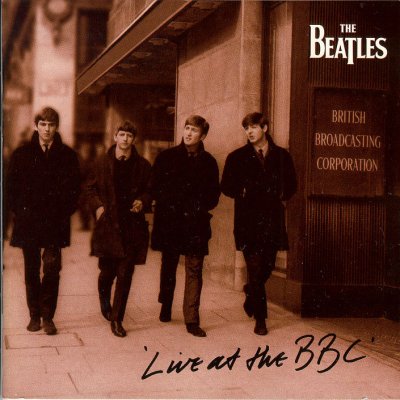 cellent job as lead vocalist on the track, popping into harmony in strategic places throughout the song. His bass work is rudimentary, described by Ian MacDonald in his book "Revolution Of The Head" as "a bass line that smacks of studio make-do, suggesting that McCartney hadn't had time to work out anything more fluent." He later redeems himself as expressive bass runs begin to surface during live performances of the song three months later, this being noted by author Ian MacDonald during their June 19th, 1963 live radio show at the Playhouse Theatre in London, this show appearing on their “Live At The BBC” album. cellent job as lead vocalist on the track, popping into harmony in strategic places throughout the song. His bass work is rudimentary, described by Ian MacDonald in his book "Revolution Of The Head" as "a bass line that smacks of studio make-do, suggesting that McCartney hadn't had time to work out anything more fluent." He later redeems himself as expressive bass runs begin to surface during live performances of the song three months later, this being noted by author Ian MacDonald during their June 19th, 1963 live radio show at the Playhouse Theatre in London, this show appearing on their “Live At The BBC” album.
 Ringo plays pretty straightforward throughout the song, riding on the hi-hat and accenting the tom-toms whenever the introduction is heard. That is to say, until the two “drum solos” appear at the end of the song. The only other occurrences of anything close to a drum solo on a Beatles record would be on “Long Tall Sally,” “Strawberry Fields Forever,” “A Day In The Life,” “Birthday” and of course “The End” from the “Abbey Road” album. Ringo plays pretty straightforward throughout the song, riding on the hi-hat and accenting the tom-toms whenever the introduction is heard. That is to say, until the two “drum solos” appear at the end of the song. The only other occurrences of anything close to a drum solo on a Beatles record would be on “Long Tall Sally,” “Strawberry Fields Forever,” “A Day In The Life,” “Birthday” and of course “The End” from the “Abbey Road” album.
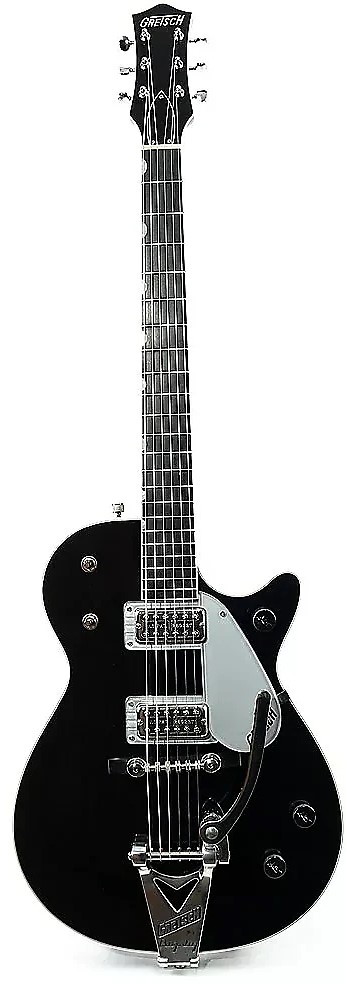 Since no guitar solo was required for the song, George Harrison takes somewhat of a backseat, playing rhythm guitar along with John throughout. Very simple yet proficient chords are played throughout the song except whenever the introduction of the song is heard. Harrison then slips into a thumping rocking style which adds the right degree of excitement to the song, especially when performed on stage. Since no guitar solo was required for the song, George Harrison takes somewhat of a backseat, playing rhythm guitar along with John throughout. Very simple yet proficient chords are played throughout the song except whenever the introduction of the song is heard. Harrison then slips into a thumping rocking style which adds the right degree of excitement to the song, especially when performed on stage.
American Releases
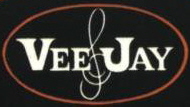 May 27th, 1963 was the first release of the song in the states, although it was unbeknownst to most of us. This was as the b-side to their second failed American single “From Me To You” on Vee-Jay Records. This mono version was the same as released in Britain, which did not contain the extra harmonica overdubs. As with its British release, the songwriting credits on both sides of this single were listed as "McCartney - Lennon." May 27th, 1963 was the first release of the song in the states, although it was unbeknownst to most of us. This was as the b-side to their second failed American single “From Me To You” on Vee-Jay Records. This mono version was the same as released in Britain, which did not contain the extra harmonica overdubs. As with its British release, the songwriting credits on both sides of this single were listed as "McCartney - Lennon."
 Since Vee-Jay decided to re-release “From Me To You” as the b-side to “Please Please Me” on January 3rd, 1964 to capitalize on The Beatles’ newfound US success, its original b-side “Thank You Girl” was overlooked temporarily. February 26th, 1964, saw the second release of the song and this time on an album, although not on an official Beatles album. “Jolly What! England’s Greatest Recording Stars: The Beatles and Frank Ifield On Stage” was released on Vee-Jay. The album only included four Beatles songs, which comprised their first two failed Vee-Jay singles including “Thank You Girl.” All the songs were, of course, not live recordings at all, but previously released studio recordings of both The Beatles and Frank Ifield. Since Vee-Jay decided to re-release “From Me To You” as the b-side to “Please Please Me” on January 3rd, 1964 to capitalize on The Beatles’ newfound US success, its original b-side “Thank You Girl” was overlooked temporarily. February 26th, 1964, saw the second release of the song and this time on an album, although not on an official Beatles album. “Jolly What! England’s Greatest Recording Stars: The Beatles and Frank Ifield On Stage” was released on Vee-Jay. The album only included four Beatles songs, which comprised their first two failed Vee-Jay singles including “Thank You Girl.” All the songs were, of course, not live recordings at all, but previously released studio recordings of both The Beatles and Frank Ifield.
 The next release of the song was on March 23rd, 1964 as the b-side to the Vee-Jay single “Do You Want To Know A Secret.” With the immense popularity of The Beatles at this time, not only did the a-side make the charts (#2) but “Thank You Girl” made the charts as well, peaking at #35 on the Billboard Hot 100. Once again, the songwriting credit here was "McCartney - Lennon." The next release of the song was on March 23rd, 1964 as the b-side to the Vee-Jay single “Do You Want To Know A Secret.” With the immense popularity of The Beatles at this time, not only did the a-side make the charts (#2) but “Thank You Girl” made the charts as well, peaking at #35 on the Billboard Hot 100. Once again, the songwriting credit here was "McCartney - Lennon."
 A somewhat puzzling but gutsy move was Capitol including the song on their second Beatles album “The Beatles’ Second Album” on April 10th, 1964. It was gutsy because of the song being currently licensed to Vee-Jay records and currently released on a Vee-Jay single. Capitol was in the middle of litigations as to who owned the rights to these early songs but decided to go ahead and put one of them on their newest album anyway. As it stood at the time, Conrad Publishing, a Vee-Jay subsidiary, had the exclusive US copyright to “Thank You Girl” which meant that Vee-Jay records received two cents for every copy of the album that sold. A somewhat puzzling but gutsy move was Capitol including the song on their second Beatles album “The Beatles’ Second Album” on April 10th, 1964. It was gutsy because of the song being currently licensed to Vee-Jay records and currently released on a Vee-Jay single. Capitol was in the middle of litigations as to who owned the rights to these early songs but decided to go ahead and put one of them on their newest album anyway. As it stood at the time, Conrad Publishing, a Vee-Jay subsidiary, had the exclusive US copyright to “Thank You Girl” which meant that Vee-Jay records received two cents for every copy of the album that sold.
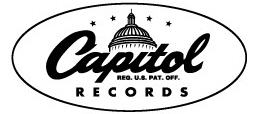 Incidentally, mono copies of this album contained a "Type B" foldover mix of "Thank You Girl" created by Capitol Records that combined both channels of the stereo mix into one instead of using the true mono mix created by George Martin that appears on the above mentioned Vee-Jay releases. Starting with this Capitol release, the songwriting credit now appears as "Lennon / McCartney" and continues as such whenever the song was released on the label. On January 21st, 2014, "The Beatles' Second Album" was released as an individual compact disc for the first time, the mono and stereo mixes being contained on a single CD. Incidentally, mono copies of this album contained a "Type B" foldover mix of "Thank You Girl" created by Capitol Records that combined both channels of the stereo mix into one instead of using the true mono mix created by George Martin that appears on the above mentioned Vee-Jay releases. Starting with this Capitol release, the songwriting credit now appears as "Lennon / McCartney" and continues as such whenever the song was released on the label. On January 21st, 2014, "The Beatles' Second Album" was released as an individual compact disc for the first time, the mono and stereo mixes being contained on a single CD.
 As a companion to this album, Capitol released a "Compact 33 Disc" for use in juke boxes across the country. This six-song EP contained "Thank You Girl" as the lead-off song on side one. This rare disc was released in April of 1964. As a companion to this album, Capitol released a "Compact 33 Disc" for use in juke boxes across the country. This six-song EP contained "Thank You Girl" as the lead-off song on side one. This rare disc was released in April of 1964.
Also in April, Capitol released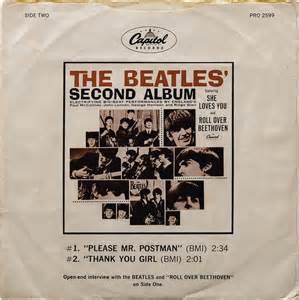 "The Beatles' Second Open-End Interview" disc to be sent to radio television stations to simulate an interview with The Beatles. This EP contained taped answers to questions, while the record sleeve contained the questions that disc jockeys could ask. Three Beatles songs from the "Second Album" also appeared on the disc, including "Thank You Girl." "The Beatles' Second Open-End Interview" disc to be sent to radio television stations to simulate an interview with The Beatles. This EP contained taped answers to questions, while the record sleeve contained the questions that disc jockeys could ask. Three Beatles songs from the "Second Album" also appeared on the disc, including "Thank You Girl."
 In August of 1964 the next release of the song occurred as the “Do You Want To Know A Secret” single was reissued on the Oldies 45 label. This was done to all of the major Vee-Jay singles (including the Tollie releases) to secure their place in the 'oldies' section of record stores after Vee-Jay had relinquished their rights to The Beatles catalog. In August of 1964 the next release of the song occurred as the “Do You Want To Know A Secret” single was reissued on the Oldies 45 label. This was done to all of the major Vee-Jay singles (including the Tollie releases) to secure their place in the 'oldies' section of record stores after Vee-Jay had relinquished their rights to The Beatles catalog.
 On October 10th, 1964, Vee-Jay tried one final attempt at cashing in on The Beatle's fame by re-releasing the Frank Ifield compilation retitled “The Beatles And Frank Ifield On Stage.” The cover was changed to a more suitable group portrait, but sold very poorly and has become a huge collector's item today. On October 10th, 1964, Vee-Jay tried one final attempt at cashing in on The Beatle's fame by re-releasing the Frank Ifield compilation retitled “The Beatles And Frank Ifield On Stage.” The cover was changed to a more suitable group portrait, but sold very poorly and has become a huge collector's item today.
 Capitol then made sure that the early Beatles singles would still be available to the public through their Star Line budget label. On October 11th, 1965, the label released the familiar “Do You Want To Know A Secret” single with “Thank You Girl” once again as the b-side. Capitol then made sure that the early Beatles singles would still be available to the public through their Star Line budget label. On October 11th, 1965, the label released the familiar “Do You Want To Know A Secret” single with “Thank You Girl” once again as the b-side.
At some point in 1967, Capitol released Beatles music on a brand new but short-lived format called "Playtapes." These tape cartridges did not have the capability to include entire albums, so two truncated four-song versions of "The Beatles Second Album" were released in this portable format, "Thank You Girl" being on both of these releases. These "Playtapes" are highly collectable today. Also released in 1967 was the 8-track version of their 1964 album "Something New" which featured "Thank You Girl" as a bonus track in order to even out the playing time of the songs between the four tracks on the tape.
 When Capitol released their 8-track version of the album "Something New" in 1968, they added "Thank You Girl" as the third track on channel three. This was done in order to flesh out the eleven songs to twelve, which could more readily be divided between the four channels of the tape. When Capitol released their 8-track version of the album "Something New" in 1968, they added "Thank You Girl" as the third track on channel three. This was done in order to flesh out the eleven songs to twelve, which could more readily be divided between the four channels of the tape.
 Because of EMI's decision to release a box set that included all of the British Beatles albums as well as an additional album entitled "Rarities" that included songs that did not appear on any British Beatles album, Capitol had initially decided to release this album in America. 2,000 promotional copies of this album were manufactured (#SPRO-8969) and then another unlimited number of advance copies (ESN-SN-12009) were printed in the fall of 1979. "Thank You Girl" was included on this proposed album which was decided to be abondoned due to the fact that this and most of the songs contained therein were available on other Beatles albums in the US at the time. These promotional albums are very collectible today. Because of EMI's decision to release a box set that included all of the British Beatles albums as well as an additional album entitled "Rarities" that included songs that did not appear on any British Beatles album, Capitol had initially decided to release this album in America. 2,000 promotional copies of this album were manufactured (#SPRO-8969) and then another unlimited number of advance copies (ESN-SN-12009) were printed in the fall of 1979. "Thank You Girl" was included on this proposed album which was decided to be abondoned due to the fact that this and most of the songs contained therein were available on other Beatles albums in the US at the time. These promotional albums are very collectible today.
 The next time "From Me To You" was paired with "Thank You Girl" on a single in America was on December 6th, 1982 as featured in the vinyl box set "The Beatles Singles Collection." When this package was released as "The Beatles CD Singles Collection" on November 11th, 1992 and as a reissued vinyl collection titled "The Singles Collection" on November 22nd, 2019, this same single was included. The next time "From Me To You" was paired with "Thank You Girl" on a single in America was on December 6th, 1982 as featured in the vinyl box set "The Beatles Singles Collection." When this package was released as "The Beatles CD Singles Collection" on November 11th, 1992 and as a reissued vinyl collection titled "The Singles Collection" on November 22nd, 2019, this same single was included.
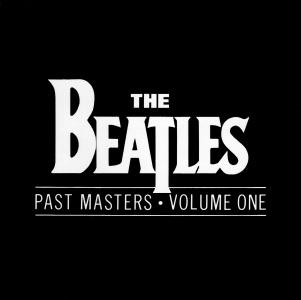 March 7th, 1988 was the date of the next release of the song, on the compilation CD “Past Masters, Volume One.” The original mono mix from 1963 was still used on this album to correspond with the version originally released in Britain. On October 24th, 1988, both volumes of "Past Masters" were combined into one double-album on vinyl, which was simply entitled "Past Masters." Then, on September 9th, 2009, the combined "Past Masters" set was released on CD in a remastered stereo state, a vinyl remastered set coming out on November 12th, 2012. On this release we finally find the stereo mix made by George Martin on March 13th, 1963 available for all to hear. With the added clarity of remastering, and without the additional reverb given by Capitol, both Britain and America can enjoy the stereo mix as it was intended to be heard. March 7th, 1988 was the date of the next release of the song, on the compilation CD “Past Masters, Volume One.” The original mono mix from 1963 was still used on this album to correspond with the version originally released in Britain. On October 24th, 1988, both volumes of "Past Masters" were combined into one double-album on vinyl, which was simply entitled "Past Masters." Then, on September 9th, 2009, the combined "Past Masters" set was released on CD in a remastered stereo state, a vinyl remastered set coming out on November 12th, 2012. On this release we finally find the stereo mix made by George Martin on March 13th, 1963 available for all to hear. With the added clarity of remastering, and without the additional reverb given by Capitol, both Britain and America can enjoy the stereo mix as it was intended to be heard.
 June 30th, 1992 was its next US release, this being the box set “Compact Disc EP Collection.” This set comprised all of the British EP’s, each on its own compact disc, the September 6th, 1963 released EP “The Beatles’ Hits” featuring the mono version of “Thank You Girl.” June 30th, 1992 was its next US release, this being the box set “Compact Disc EP Collection.” This set comprised all of the British EP’s, each on its own compact disc, the September 6th, 1963 released EP “The Beatles’ Hits” featuring the mono version of “Thank You Girl.”
 The next release was on December 6th, 1994 on the highly anticipated “Live At The BBC” double disc. The BBC performance of the song was recorded before a live audience at the Playhouse Theatre in London on June 19th, 1963, which was while the newly released single was current on the British charts. A remastered and re-packaged version of this album was released on November 11th, 2013. The next release was on December 6th, 1994 on the highly anticipated “Live At The BBC” double disc. The BBC performance of the song was recorded before a live audience at the Playhouse Theatre in London on June 19th, 1963, which was while the newly released single was current on the British charts. A remastered and re-packaged version of this album was released on November 11th, 2013.
On November 15th, 2004, Capitol released the box set “The Capitol Albums, Volume 1,” which included both the stereo and "Type B" foldover mono mixes as originally heard in the US on “The Beatles’ Second Album.”
 For those who want to hear the original mono mix of the song with the best clarity possible, the September 9th, 2009 released CD box set “The Beatles In Mono” is for you. The disc “Mono Masters,” which is contained in this set, includes the newly remastered "Thank You Girl." The vinyl edition of this box set first came out on September 9th, 2014. For those who want to hear the original mono mix of the song with the best clarity possible, the September 9th, 2009 released CD box set “The Beatles In Mono” is for you. The disc “Mono Masters,” which is contained in this set, includes the newly remastered "Thank You Girl." The vinyl edition of this box set first came out on September 9th, 2014.
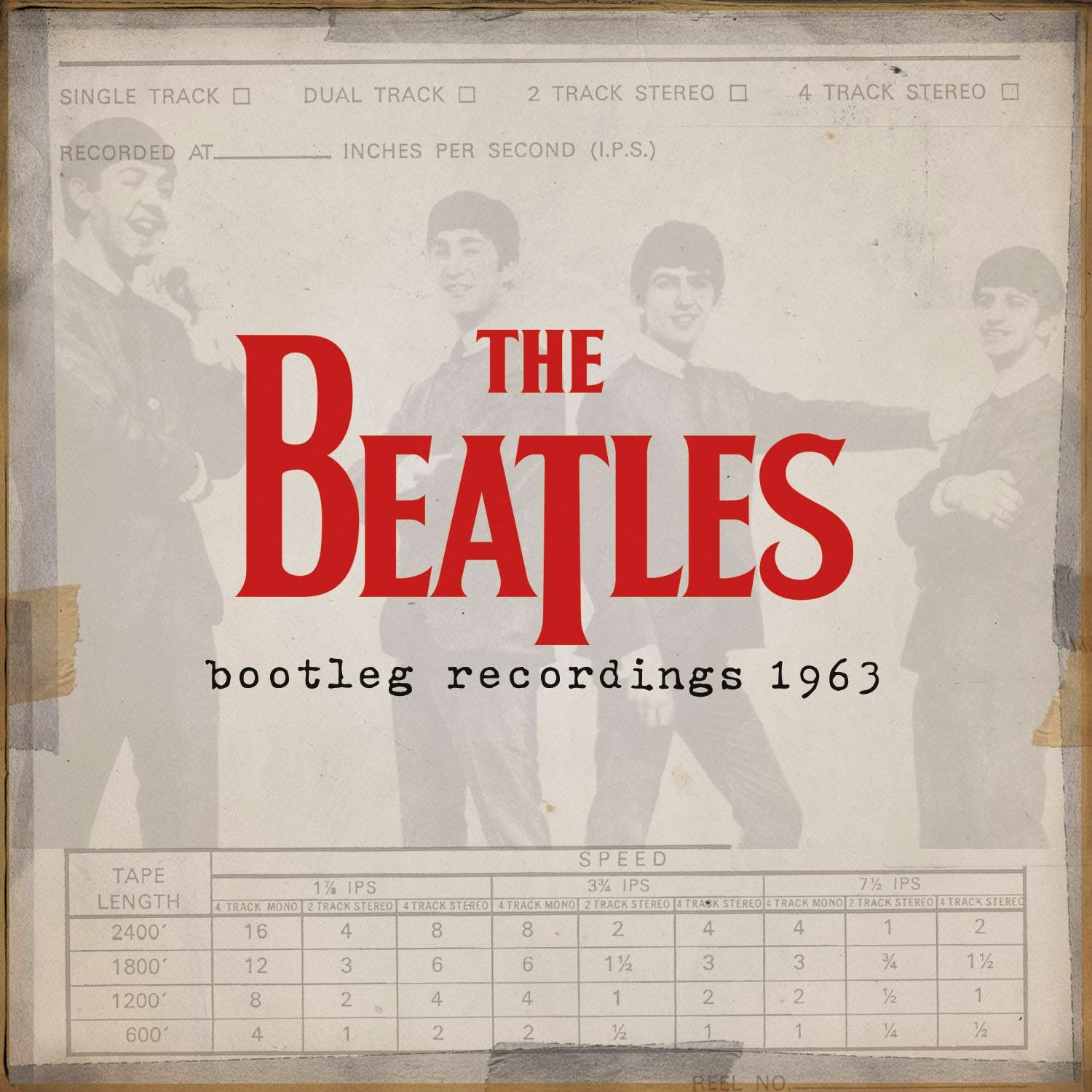 On December 17th, 2013, iTunes released a 59 track compilation album entitled "Bootleg Recordings 1963" only available on their downloading platform, studio takes 1 and 5 of "Thank You Girl" from the group's March 5th, 1963 EMI recording session included therein. The purpose of this release was to extend the copyright of these recordings under European Union law from 50 years (which would have expired at the end of 2013) to 70 years (until 2033), this being considered an official release. This compilation album was only available in the US on that date to those in the know for a number of hours for $39.99 in its entirety or to be purchased as individual tracks, but was later made available for purchase as well. On December 17th, 2013, iTunes released a 59 track compilation album entitled "Bootleg Recordings 1963" only available on their downloading platform, studio takes 1 and 5 of "Thank You Girl" from the group's March 5th, 1963 EMI recording session included therein. The purpose of this release was to extend the copyright of these recordings under European Union law from 50 years (which would have expired at the end of 2013) to 70 years (until 2033), this being considered an official release. This compilation album was only available in the US on that date to those in the know for a number of hours for $39.99 in its entirety or to be purchased as individual tracks, but was later made available for purchase as well.
Live Performances
 As was their habit, The Beatles would extensively promote both sides of their latest single through performances on stage, radio broadcasts and on television. Once their national tour with Tommy Roe and Chris Montez was completed in March of 1963, the group wasted no time promoting their third single, performing it first on April 1st, 1963 for the BBC radio show “Side By Side,” which was premature of the single being released on April 11th, 1963. Since the radio show wasn’t broadcast until May 13th, 1963, the audience was undoubtedly familiar with the song by then. As was their habit, The Beatles would extensively promote both sides of their latest single through performances on stage, radio broadcasts and on television. Once their national tour with Tommy Roe and Chris Montez was completed in March of 1963, the group wasted no time promoting their third single, performing it first on April 1st, 1963 for the BBC radio show “Side By Side,” which was premature of the single being released on April 11th, 1963. Since the radio show wasn’t broadcast until May 13th, 1963, the audience was undoubtedly familiar with the song by then.
 “Thank You Girl” became a comfortable fixture of their live sets for the next few months. One noteworthy performance was on their first national BBC network TV show “The 625 Show,” which was filmed on April 13th, 1963 and broadcast on April 16th, 1963, this program billed as featuring “up and coming young talent.” "Thank You Girl" was still part of their set list during their six night residency at the Gaumont Cinema in Bournemouth, Hants, England, from August 19th through 24th, 1963, as their second song after opening with "Roll Over Beethoven." Their last known performance of "Thank You Girl" was on August 31st, 1963 at the Odeon Cinema in Southport. “Thank You Girl” became a comfortable fixture of their live sets for the next few months. One noteworthy performance was on their first national BBC network TV show “The 625 Show,” which was filmed on April 13th, 1963 and broadcast on April 16th, 1963, this program billed as featuring “up and coming young talent.” "Thank You Girl" was still part of their set list during their six night residency at the Gaumont Cinema in Bournemouth, Hants, England, from August 19th through 24th, 1963, as their second song after opening with "Roll Over Beethoven." Their last known performance of "Thank You Girl" was on August 31st, 1963 at the Odeon Cinema in Southport.
 August 23rd, 1963 was the release date of their fourth single “She Loves You” and all focus left off of promoting the b-side to their previous single at this point. That being the case, even with the song reaching the Top 40 in America in the spring of 1964, it was never performed on US shores. August 23rd, 1963 was the release date of their fourth single “She Loves You” and all focus left off of promoting the b-side to their previous single at this point. That being the case, even with the song reaching the Top 40 in America in the spring of 1964, it was never performed on US shores.
Conclusion
 This thumping rocker has the vibrancy that epitomized the early Beatles sound in 1963 Britain and 1964 America. Although it was only a minor triumph on the charts, it showed that Lennon and McCartney took songwriting very seriously. No filler b-sides were ever considered for Beatles singles. They took pride in what they included on their singles. Every b-side The Beatles ever released was considered “top-notch” by the band. While some may point to weaker b-sides, such as “What Goes On?” and “Slow Down” as evidence of the contrary, one must remember that these were US singles only. The Beatles had nothing to do with the release of these songs as singles. From 1962 to 1970, every original single released by The Beatles had b-sides that were strong enough to stand on their own. From “This Boy” and “Rain” to “Come Together,” only the best was good enough for Beatles singles. This thumping rocker has the vibrancy that epitomized the early Beatles sound in 1963 Britain and 1964 America. Although it was only a minor triumph on the charts, it showed that Lennon and McCartney took songwriting very seriously. No filler b-sides were ever considered for Beatles singles. They took pride in what they included on their singles. Every b-side The Beatles ever released was considered “top-notch” by the band. While some may point to weaker b-sides, such as “What Goes On?” and “Slow Down” as evidence of the contrary, one must remember that these were US singles only. The Beatles had nothing to do with the release of these songs as singles. From 1962 to 1970, every original single released by The Beatles had b-sides that were strong enough to stand on their own. From “This Boy” and “Rain” to “Come Together,” only the best was good enough for Beatles singles.
Song Summary
“Thank You Girl”
Written by: Paul McCartney / John Lennon
-
Song Written: February, 1963
-
Song Recorded: March 5 and 13, 1963
-
First US Release Date: May 27, 1963
-
-
First US Album Release: Vee Jay #VJLP 1085“Jolly What!”
-
Highest Chart Position: #35
-
British Album Release: Parlophone # PCM 1001 “Rarities”
-
Length: 2:01
-
Key: D major
-
Producer: George Martin
-
Engineers: Norman Smith, Richard Langham, Geoff Emerick
Instrumentation (most likely):
-
John Lennon - Lead Vocals, Rhythm Guitar (1958 Rickenbacker 325), Harmonica (Hohner Chromatic)
-
Paul McCartney - Lead Vocals, Bass Guitar (1961 Hofner 500/1)
- George Harrison - Lead Guitar (1957 Gretsch Duo Jet)
- Ringo Starr - Drums (1960 Premier 58/54 Mahogany)
Written and compiled by Dave Rybaczewski
|
IF YOU WOULD LIKE TO MAKE A DONATION TO KEEP THIS WEBSITE UP AND RUNNING, PLEASE CLICK BELOW!
Sign Up Below for our MONTHLY BEATLES TRIVIA QUIZ!
|